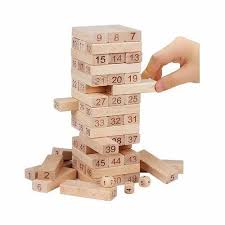Jenga Game was created in the late 1970s by Leslie Scott, a British game designer. The name “Jenga” comes from the Swahili word “kujenga,” which means “to build.” Scott developed the game using wooden blocks that could be stacked into a tower. The idea was simple yet engaging: players would take turns removing blocks from the tower and placing them on top without causing it to topple.
Scott first introduced Jenga at a toy fair in Nuremberg, Germany, in 1983, and the game quickly gained popularity. By the late 1980s, Jenga was widely recognized and became a household name, thanks in part to its easy-to-learn rules and the suspenseful nature of gameplay.
How to Play Jenga
Game Components
The classic Jenga set consists of 54 rectangular wooden blocks, each measuring 1 inch by 2.5 inches by 7.5 inches. The blocks are stacked in rows of three, alternating the direction of each layer to create a stable tower.
Objective
The objective of Jenga is to remove a block from the tower and place it on top without causing the tower to collapse. Players must use steady hands and strategic thinking to successfully navigate the game.
Gameplay Mechanics
- Setup: Players stack the blocks in a tower formation, ensuring that each layer consists of three blocks placed perpendicular to the one below it.
- Taking Turns: Players take turns removing one block at a time from any layer of the tower (except the topmost layer) and placing it on the top.
- Winning the Game: The game continues until the tower collapses. The last player to successfully remove and stack a block before the collapse is declared the winner.
Strategies for Success
- Observation: Players should pay attention to the stability of the tower and look for blocks that are easier to remove without disturbing the structure.
- Gentle Touch: A steady hand is crucial. Players must remove blocks slowly and carefully to minimize movement in the tower.
- Patience: Sometimes, waiting for an opportunity when the tower is more stable can lead to a successful turn.
Cultural Significance
Jenga’s appeal lies in its simplicity and the excitement it generates. The game encourages social interaction, laughter, and friendly competition, making it a popular choice for gatherings. Its accessibility makes it suitable for a wide range of ages, fostering connections across generations.
Jenga has also inspired various adaptations and themed versions, including giant outdoor Jenga for parties and custom sets featuring unique designs. The game’s popularity has led to its inclusion in popular culture, appearing in television shows, movies, and competitions.
Conclusion
Jenga is more than just a game; it is a blend of skill, strategy, and social interaction that has captivated players around the world. Its timeless appeal and ability to bring people together make it a staple at gatherings, ensuring that it will remain a favorite for years to come. Whether played casually with friends or in a competitive setting, Jenga continues to provide endless fun and excitement, one block at a time.




